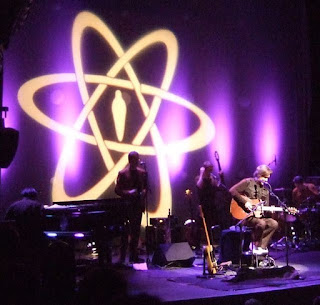David Sylvian at "La Cigale" (The world is everything tour)

Mr David Sylvian in Paris: yesterday evening at the Cigale. The Cigale is one of the oldest concert venues in Paris, perhaps a hundred years old now. Full of wrought iron railings, red seats. Perhaps a little dark. The last time I saw Mr. Sylvian in concert was at the Teatro Manzoni in Bologna. Bologna being the incredibly dense and compact place that it is, I didn’t know that this venue even existed, a short few metres from my house on the other side of the Via Independenzia, until the concert. Watching the soundcheck through an open backstage door, in the middle of a Saturday afternoon, I imagined that Mr. Sylvian might be nearby, perhaps sipping an espresso at the Caffe Impero or any one of the other myriad bars in the centre of Bologna.
Last night’s concert was very different from that of Bologna in 2003. Back then, Mr. Sylvian appeared on stage with only one other musician, his brother and drummer Steve Jansen; behind them, a swirling procession of images crossed the walls thanks to the visual artist Masakatsu Takagi, which lent one believe that one might almost understand what each song was really about. On stage, the sound was raw and spiky, full of static and clicks, with Derek Bailey’s er — difficult — guitar improvisations providing backdrop for many of the songs. Mr. Sylvian’s voice lent an incredible contrast to these difficult textures and made them bearable. There was some terrible story to tell here, and Mr. Sylvian played all the songs from Blemish in the exact same order as on the CD so that in the end we understood.
Yesterday evening we had left some of this difficult terrain behind. Sylvian was on stage with several other musicians to present work from his most recent studio album, “Snow Borne Sorrow”. I was curious to see how this would work: I had read in interviews that each track was assembled in the dead of night using Pro Tools and that most of the musicians had never actually played together before. And the sound was so intricately, flawlessly engineered, there was a certain perfect crystalline form to it, yes, like a snowflake. How could this be reproduced in concert?
In the end, perhaps I should not have been too concerned. After the first initial shock of hearing Mr. Sylvian’s voice once more, always fuller and more resonant than it could ever sound on the little loudspeakers in my apartment, I realised that of course each composition was strong enough to exist by itself, out in the world. After all, as Mr. Sylvian explained in interviews, many of these songs had come into existence in the cold New England mid-winter: a mild September evening in Paris could hardly be so threatening. The depth and emotion in the new songs are astonishing; they stand up very well against the rest of Mr. Sylvian’s work. They are as good as anything he has written, even back to the legendary “Secrets of the beehive”.
Mr. Sylvian’s fellow musicians made it easy to shape the older songs into a jazz idom, which worked very well for some (“Ghosts”, for example) and less well for others (in “Fire in the Forest” I thought the buzzing electronics were a bit too far back in the mix for my liking). But still a wonderful evening, Mr. Sylvian’s beautiful voice and thoughtful lyrics were as captivating as ever. Mr. Sylvian has created a very interesting and unique corner for himself in modern music, in a strange land somewhere between pop and jazz and new music and surrounded himself with extremely talented and inventive performers; two of the most moving tracks of the evening were written by a fellow musicians from his Samadhi sound label. I’m looking forward to the next installment already, in the shape of brother Steve Jansen’s forthcoming “Slope” album.
Technorati Tags: David Sylvian, The world is everything tour, La Cigale
